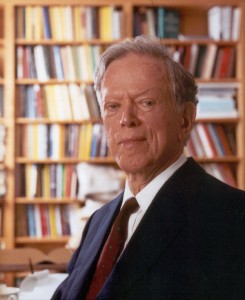
Patrick Suppes (Credit: Stanford Univ.)
This morning I wrote a blog post about the slow page of computer-assisted instruction for classrooms. Despite the ubiquity of low cost computing (think of all the smart phones in circulation, many owned by young students), computers are still hardly ever used to facilitate instruction. While the problem is most keen in STEM education, Billie and I had many conversations over the years about where computers could help. Her interests centered on early childhood, but our mutual interests ranged beyond that.
In the 70’s at the Navy Personnel R&D Center, there were many initiatives related to CAI. Some of these were pioneered by folks like Dewey Kribs (who has remained influential in DoD educational research). Patrick Suppes was an early advocate, and his work dates to the 60’s. His Wikipedia page explains:
In the 1960s, Suppes and Richard C. Atkinson (the future president of the University of California) conducted experiments in using computers to teach math and reading to schoolchildren in the Palo Alto area. Stanford’s Education Program for Gifted Youth and Computer Curriculum Corporation (CCC, now named Pearson Education Technologies) are indirect descendants of those early experiments. At Stanford, Suppes was instrumental in encouraging the development of high-technology companies that were springing up in the field of educational software up into the 1990s, (such as Bien Logic).
Sadly, that was nearly half a century ago. So many of the concepts Billie worked on – especially component-based learning and simple student progress tracking with deep granularity — need software assist. Yes, the notion of “learning object” has been codified, as seen in SCORM / “Tin Can” standards. There is progress, but Learning Management System implementations seem to be aimed at adult learning settings.
Billie and I would still be lamenting the lack of progress. It’s looking like I will have to pass that lament to sons Blake and Loren.